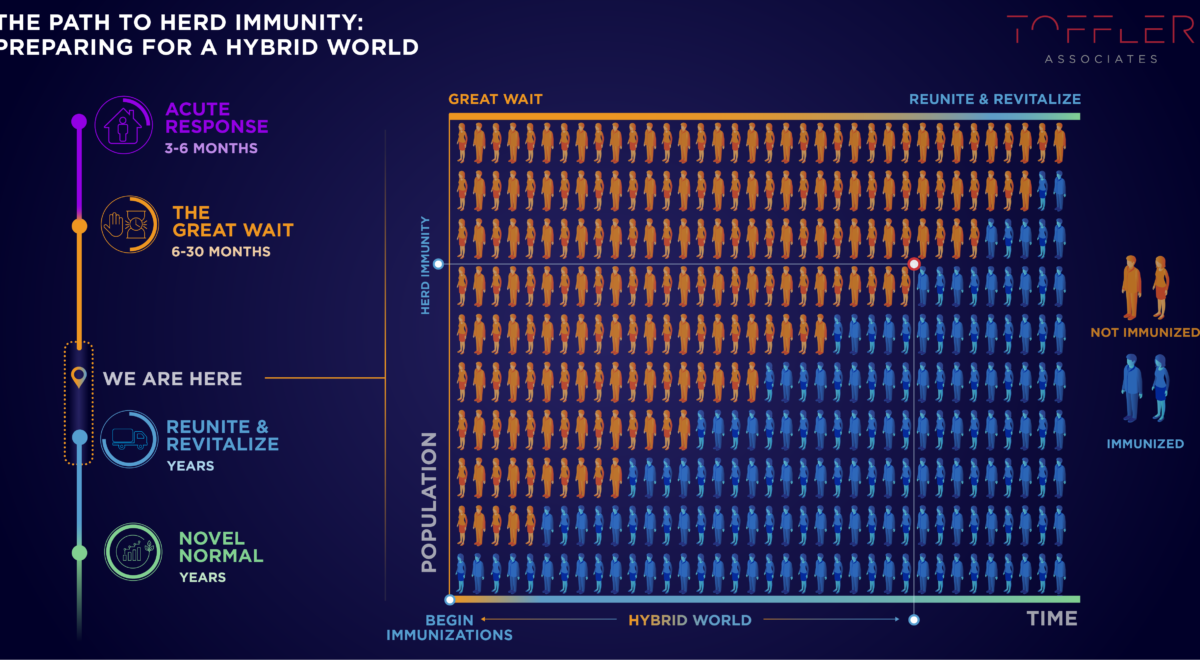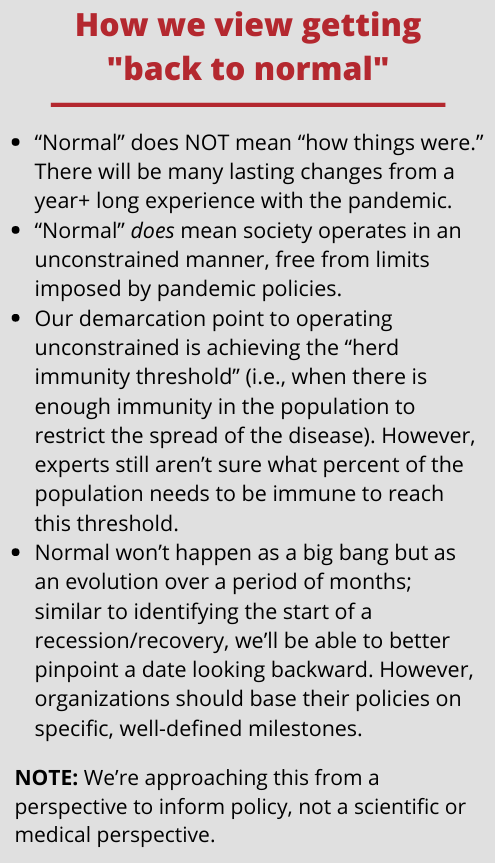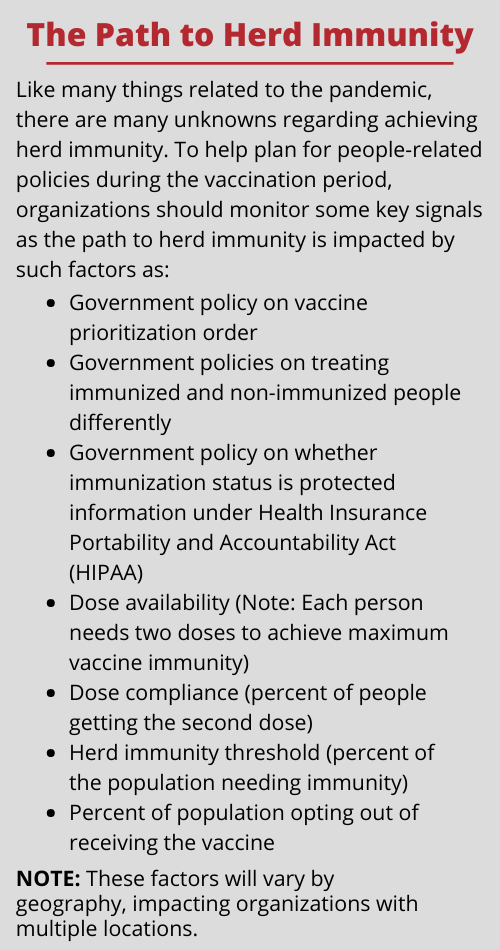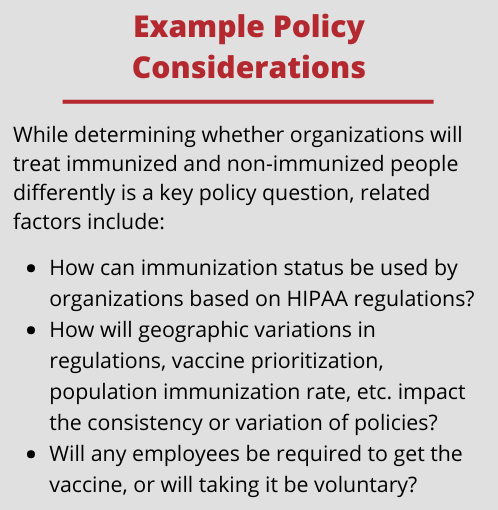COVID-19 Vaccine Distribution: The Storm Before the Calm

New Challenges Before Getting Back to Normal
In May, as the country was coming out of total lockdown, we wrote about the beginning of The Great Wait phase and the challenges it would bring. The “wait” was for vaccines that would allow the world to return to operating in an unconstrained manner. The challenges were from the friction between trying to balance minimizing the health impacts of the pandemic vs. the economic, social, and mental impacts of social distancing.
 While the end of the Great Wait seems to be on the horizon after the FDA’s December 11th announcement of approval of the Pfizer-BioNTech COVID-19 vaccine, the vaccine distribution period will be defined by a new set of challenges.
While the end of the Great Wait seems to be on the horizon after the FDA’s December 11th announcement of approval of the Pfizer-BioNTech COVID-19 vaccine, the vaccine distribution period will be defined by a new set of challenges.
The source of these challenges over the next several months comes from one core issue: the population will be divided between those who have COVID-19 antibodies (from prior infections or vaccines) and those who do not, creating a “Hybrid World” until the country can hit a point of herd immunity. Therefore, friction will be caused by how society – from individuals to families, to businesses, to government entities – either treats immunized people differently than non-immunized people or treats them similarly.
Organizations that understand, prepare for, and monitor these frictions will weather the storm with greater stability, design better interactions with people, and be proactive, not reactive.
[See the sidebars on the definitions, milestones, and signals we’re using.]
The Implications of a Hybrid World
As of now, the majority of the population is still vulnerable to COVID-19. Therefore, current policies and practices are generally designed to be consistently applied across society, with some exceptions. This is about to change with the introduction of the vaccine.
As individuals are vaccinated, they will become “free” and will expect to be excluded from protective constraints. At the same time, the non-immunized population will still, to some degree, need to operate within these constraints. This bifurcation, between the immunized and the non-immunized, promises new territory for friction and polarization within society.
 In order to successfully navigate the period between the start of the vaccinations and the point of herd immunity, organizational leaders must proactively analyze the environments in which they operate (e.g., employees, customers, locations, stakeholders, supply chain, regulatory jurisdictions) and decide what they can and can’t control and how they will interact with immunized and non-immunized people.
In order to successfully navigate the period between the start of the vaccinations and the point of herd immunity, organizational leaders must proactively analyze the environments in which they operate (e.g., employees, customers, locations, stakeholders, supply chain, regulatory jurisdictions) and decide what they can and can’t control and how they will interact with immunized and non-immunized people.
- For what can be controlled, the central question is whether organizations will create tiered policies that treat immunized and non-immunized people differently or treat everyone equally. Either answer creates challenges in this new Hybrid World; however, it’s critical for organizations to explore the pros and cons of each position and how they may segment the populations they interact with.
- For what can’t be controlled, organizations will need to monitor the policies that are dictated to them and determine how those will impact their operations; again, this will center on the question of whether or not immunized and non-immunized people will be required to be treated similarly or differently.
As illustrated in the above graphic, two other factors are critical to policy-setting in this Hybrid World:
- The time between the start of vaccine distribution and when society reaches herd immunity (i.e., when we can operate in an unconstrained manner); the longer this period is, the more important it will be to formalize policies.
- The impact of the immunized/non-immunized ratio; will policies be different when 20% of employees/customers/communities are immunized vs. when it climbs to 60%? What is the trigger point for a change in policies?
Analyzing potential scenarios helps with policy development.
Knowing that the Hybrid World may last for several months and that it will bring a high degree of uncertainty, it’s important for organizations to prepare for multiple scenarios rather than try to predict a single outcome. To start, the following offer some considerations for how to prepare for this period.
Understand the people your organization interacts with. Vaccine distribution will not happen evenly across society; therefore, organizations should understand the segmentation of the population they interact with and consider the following questions:
-
- What is the order of vaccine distribution, and how does that intersect with the workforce, customer, and community demographics?
- How could vaccine penetration (e.g., speed, rate, ratio) differ across the different geographies and demographics the organization serves?
- What percentage of the relevant population could opt out of getting the vaccine for medical or personal reasons?
 This Pew Research Center survey provides an interesting demographic analysis of vaccine attitudes that can inform policy.
This Pew Research Center survey provides an interesting demographic analysis of vaccine attitudes that can inform policy.
Develop and plan for various scenarios. Think through what a hybrid population of employees, customers, stakeholders, etc. would look like and what issues could arise. Develop plans for these scenarios. Friction points – where people disagree with policies or each other – should be identified and responses defined to minimize negative impacts.
Identify the milestones that are important. Every organization will have a different set of levers, drivers, and milestones that the people it interacts with will be influenced by (e.g., immunization ratio, speed of immunization, two-dose compliance rate, percent opting out). Monitoring mechanisms should be put in place to track those milestones – at segment and geography levels, if needed – to effectively implement and adjust policies and practices.
Take a broad societal, ecosystem perspective. As the pandemic has illustrated, we live in a truly global, interconnected society. The variation of local and national policies, societal behaviors, and immunization rates have to be considered in organizations’ policies.While every organization might not be directly impacted, there may be some indirect impact from international events and policies that should be considered.
Successfully navigating the uncertainty of the Hybrid World
As 2020 comes to a close, the creation of a vaccine for COVID-19 is a landmark of human ingenuity, despite the turbulence experienced this year. While we are all eager to “get back to normal,” until the herd immunity threshold is reached, organizational leaders will need to expect a period of instability and uncertainty created by a hybrid-immunized population.
Toffler Associates has been helping organizations analyze and prepare for uncertainty for nearly 25 years by using tools such as scenario planning. Approaches like this can help organizations mitigate friction within their hybridized workforce, customers, and operations and achieve success despite the upcoming challenges.
Please contact us if you would like to understand how foresight and scenario planning can help your organization navigate the Hybrid World and prepare for success.
Denise Sughrue, Katherine Wagner, and Rebecca Onyango provided significant support for this article.
{{cta(’00caf38e-bdff-43b8-ad8e-dfd47ecef19b’)}}
Other COVID-19 resources:
- Categories
- Strategic Planning
- Workforce of the Future


 About the Authors
About the Authors